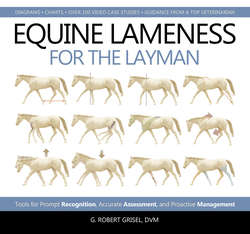Читать книгу Equine Lameness for the Layman - G. Robert Grisel DVM - Страница 33
На сайте Литреса книга снята с продажи.
2 The Responsibility of the Veterinarian in Successful Management of Equine Lameness
ОглавлениеThirty years ago, visual examination was the primary tool that veterinarians employed to evaluate lame horses. Back then I was fortunate enough to work under the tutelage of legendary veterinarians like Ted Stashak (Colorado State University) and Marvin Beeman (Little Large Animal Clinic), who would extract vast amounts of information during their clinical lameness examinations. Through meticulous inspection and a methodical approach, these practitioners would formulate a visual impression of the horse’s movement for the purpose of discerning clinical significance(s). The ability to “decode” individual gait characteristics enabled them to more quickly and accurately diagnose problems. Exceptional clinicians like Drs. Stashak and Beeman (affectionately referred to as “leg men”) realized that horses with similar pathology would display consistent patterns of abnormal movement (or gait deficits). This approach to evaluation was more representative of “art” than medicine, but often allowed the practitioner to accurately interpret the relationship between certain physical gestures and probable sources of lameness.
Nowadays, veterinarians don’t rely nearly as much on visual examination during their diagnostic workup of the lame horse. This is largely attributed to recent advancements in diagnostic imaging and inertia (motion) sensing. A variety of supplemental tools (also known as “toys”) allow today’s veterinarian to reach a diagnosis with more confidence and less subjectivity.
Unfortunately, the improved technology also tempts today’s veterinarian to spend less time and energy on visual examination and more time retrieving electronic data from a machine. Although we gain valuable information via the use of advanced diagnostic modalities, we can also sacrifice time and direction by compromising the visual aspect of the clinical evaluation.
We rely on the veterinarian to accurately diagnose and treat lameness. Equine veterinarians can do both the horse and the horse owner a further service by getting involved in the recognition phase of lameness management. Through the use of regular telemedical evaluation (remote video analysis)3,4, the veterinarian can help the owner avoid allowing subtle issues to go unchecked.
This strategy can also facilitate post-treatment management of lame horses by providing the veterinarian with regular “virtual views” of their patients in motion. Adjustments to the treatment strategy can be made as necessary depending on updated visual impression(s). Of course, this tool becomes more valuable as the veterinarian’s ability to scrutinize footage continues to improve.
The clinical examination, although subjective, is still the most important diagnostic modality available because the information gathered during this portion of the evaluation tells the veterinarian where to look. And a veterinarian who knows where to look for the problem is more likely to find it.
